
Vis is a Croatian island in the Adriatic Sea, with an area of 90.26 km² and a population of 3,617 (as of 2001[update]). Of all the inhabited Croatian islands, it is the farthest from the coast. The highest peak of Vis is called Hum, 587 m high.
There are two towns and municipalities on the island, Vis (1,960 inhabitants in the municipality) and Komiža (1,677 , both located on the seacoast. There are smaller settlements on the island's interior: Podselje, Marinje zemlje, Podšpilje, and Podstražje.
The town of Vis is located in the north-eastern part of the island Vis in the bottom of a well protected bay. It developed from the former settlements Kut and Luka, which became one entity in the 16th century by the building of the church Gospa od Spilica.
The villages from the eastern side of the island such as: Zenka, Milna, Bargujac, Podstražje, Podselje, Plisko Polje and Marine Zemlje gravitate to the town. Since the World War II the whole island had been a military area.
The tourism on Vis began to develop significantly with the demilitarisation of the island at the beginning of the war (1991-1995) in Croatia. So, it has been only 15 years ago that both the island and its town opened for the visit of tourists. The remains of the military objects in the northwest and northeast part of the Bay of Vis are the witnesses of the stay of the Yugoslav Army.

During the last hundred years a part of the population emigrated in the search for better living conditions. There are only about 2000 people living in the town of Vis, and around 3500 on the whole island.
The fortresses and the stony piles testify to the thousand-year-old settlement on Vis, and the remains of a theatre built into the foundations of the Franciscan monastery on the peninsula Prirovo, antique therms or the Hellenistic cemetery, confirm that Vis is one of the oldest urban centres in Croatia.

The town Vis, the antique Issa, was founded by the tyrant of Syracuse Dionisius the older about 397 B.C. as a base for the Greek colonization of the Adriatic Sea. The settlement of Dionisius had been located in the part of the town, which is now called Gradina and on the peninsula of Prirovu.
In the Hellenistic time Vis had been so powerful that it established its own colonies on the location of the today towns of Trogir, Stobrec and Lumbarda on Korcula island. Many archaeological remains testify to the development of Vis. You cansee the most beautiful example of antique art on Vis in the archaeological collection of the Museum of Vis, which is located within the fortress Batarija: the bronze head of the goddess Artemida.

Beside it there are also other valuable antique works as the head of men and women, ceramic vases of various forms, vessels, and especially a collection of amphora, which were taken out of the sea near the town.
A special archaeological importance are Hellenistic gravestones (stele) found in the town area Mrtvilu on the western side of the today sport- grounds.
The natural conditions and the tradition has determined the development of the economical activities of the inhabitants of Vis. Due to many areas of cultivable and quality land, especially in the fields around the town Vis the agriculture has always been the main part of the economy.

The wine-growing has been the most important activity of the local inhabitants since the antique times, and so the writer Agatarhid told us "how the vine from Issa, an island in the Adriatic sea in comparison with others better". On the other side the rich fishing grounds in this part of the Adriatic
Sea have influenced the development of fishing. Beside the mentioned activities the main factor today are services, and especially tourism.
The town Vis has a rich culturally-monumental heritage from the newer age. There are many summer- cottages, fortresses and palaces.

If starting from Kut, which is on the southeast part of the port and the bay, you will also pass by the palace of Jakin, palace of the poet Petar Hektorovic, Petrinovics palace, the house where one of the best Croatian writers Ranko Marinkovic was born, Prdvarics palace and Gazarovics palace. There follow the palace of Gariboldi and the famous Vila Kaliopa, and the Austrian fortress Batarija.
On the port there are waiting the palaces of Mardesicev, Radosijev, Vukasinovic-Dojmijev and the Tramontana palce, and the tower Perasti. Outside the town there are the English fortresses Terjun, Fortica and Velington.

We can point out of the sacral architecture and art especially the pre Romanic Church of St. Jurje (St. George is the patron of the town and is celebrated on April 23rd) in the bay of the same name in the near of the Czechvilla and the Church of St. Marija in Podselju - the spiritual centre of the island, where the inhabitants of Vis pilgrim on Mary Ascension.
Among the other sacral objects you should visit the church of St.Ciprian and Justine on Kut, the Church of Gospa od Spilica, which connects Kut and the harbour, and the Franciscan monastery on the peninsula of Prirovo.
There is a primary and the high-school "Antun Matijesevic-Karamaneo" in Vis.
Inside the town you can deal with various sport- activities. There is well-equipped sport- and recreation centre with four tennis-grounds, a basketball and a football-ground. You also have a sailing, a cricket and a paragliding club in Vis. It is possible to dive outside the town together with other divers in two diving-centres. You can also go mountain climbing and drive bicycle.
The town Vis offers around 1500 beds in private houses and apartments and about 400 beds in hotels. You shall not miss one of the ten restaurants in the town or one of the taverns/ konobas which are parts of the rural households outside the town. You should taste the domestic specialities like domestic bread from Vis, and pilchards from the grill.
During the year there are a lot of interesting manifestations, especially the New Years Eve on open air, the carnival and the International Festival of amateur Theatre in May, the Cultural Summer of Vis with concerts and theatre during the summer months, and a sailing regatta in October.
Milna

Milna is a small town and bay situated on the southern side of the island of Vis, close to the town of Rukovac. Milna is 9 km away from the city of Vis and 20 km from Komiža. The bay has sand and pebble beaches, and a few hundred meters away is the beautiful sand beach Zaglav, which along with Srebrena, is one of the most beautiful beaches on the island of Vis.
The view from the bay stretches to the nearby islands among which Budihovac is known for its two beautiful beaches and Ravnik, for the natural phenomena "The Green Cave". The town has a market and restaurant and there is the possibility of renting motor boats for sight-seeing the nearby bays and islands. The Milna bay represents an ideal destination for those who look for a quiet family vacation in a beautiful natural environment. The kind hosts and quality accommodation in private houses and apartments guarantee an unforgettable vacation on the beautiful island of Vis.
Trogir, the center of the Trogir Riviera is a town with approximately 13000 inhabitants, situated in the heart of Dalmatia, 20 km west from the city of Split. The Adriatic tourist road is located in its immediate vicinity and connects it well with neighboring places: Kaštela, Solin, large center - Split, and smaller municipalities: Seget, Marina and Okrug (on the island of Čiovo) which were once part of this Riviera.
Frequent bus connections with the surroundings make it approachable from all sides, and also with other large Croatian centers. The boat routes towards Split and the neighboring island of Drvenik Veliki and Drvenik Mali are also good, especially during the summer season.
The vicinity of the airport connects the town with the entire world.
The natural protection and spaciousness of the harbor, the favorable accommodation on the small island between the land and the island of Čiovo, and the fair climate were the main reasons for establishing the town.
Many nations have changed and mutually assimilated in this small area: Illyrians, Greeks, Romans, and then Croats. It was also under Venetian, French, and Austrian authority. They have left their traces, but despite all of this, the Croatian people and their language stayed preserved during the stormy Trogir centuries till the present day.
The city of Trogir, Marina, Seget Donji, Seget Vranjica, Vinišće and the island of Čiovo make up the Trogir Riviera. This area is rich with Mediterranean vegetation, olive groves and vineyards, numerous islands and bays, sand and pebble beaches .
Except for high quality accommodation in hotels, boarding houses, apartments, camps and homemade delicacies, especially fish specialties, it also offers a wide variety of sport and recreation. The coast of the Trogir Riviera is separated with smaller bays, capes, and islands with lush Mediterranean vegetation, still preserved in its original form.
This is favorable for those who are attracted to cruising along the Adriatic coast. The climate is favorable with mild winters and warm summers which are cooled by the pleasant wind – the maestral.
Town Trogir
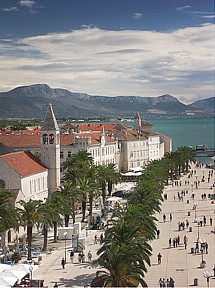
The town was settled in the 3rd century, but people lived in this area before. The Greek colony Tragurion was established by seamen, who came from the island Vis. Trogir was famous in the Roman Empire because of its excellent marble. A few reliefs from the antique history of Trogir are preserved like the one of Kairos (4th-3rd century B.C.) and a work, which represents a woman on a loom (2nd-1st century B.C.).
Trogir has been under the rule of the Byzanthian Cezar and his Exarch in Ravenna since Dalmatia became a region - a themate of the East Roman Empire.
A new population settled with the time around the town - the Croats, who wrote the second page in the history of this area. The Hungarian- Croatian king guaranteed the town an autonomy in 1107 and it was on power till the arrival of the Venetians.
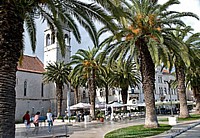
The communal autonomy based on the town statute from 1332 and the privileges of Coloman also developed in those centuries. The early Romanic church of St. Barbara from the lllh century is especially worth to mention.
The period from the 13th to 15th century represents the top of the social, economic, cultural and artistic power of Trogir. This was the time of big buildings, the improvement of the fortification system with walls and fortresses, which surrounded the town completely.
This was also the time of the dukes of Bribir from the dynasty Subic, of the humanist and writer Koriolan Cipico and the Croatian Ban Petar Berislavic, who has been famous as a fighter against the Turks in the Croatian history.
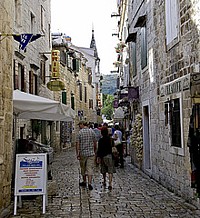 Domestic masters and artists have left their impressive works behind: Radovan, Blaz Jurjev Trogiranin ,Ivan Duknovic, and also Andrija Alesi and Nikola Firentinac.
Domestic masters and artists have left their impressive works behind: Radovan, Blaz Jurjev Trogiranin ,Ivan Duknovic, and also Andrija Alesi and Nikola Firentinac.The cathedral of St. Lovre with the famous Portal of Radovan is a church where we can find styles from the Romanic to the Baroque and numerous artists left their traces behind in it. The art collection of the cathedral protects the most worthy culture and art heritage of the town Trogir. It is located on the main square that is the same as in the time of the antique founding of the city.
The cathedral is beside the town hall, court, the town tower and one of the most beautiful palaces - Cipiko.
The influence of Venice is recognizable in the culture and architecture from 1420. to 1797., but the Croatian language survived during the 400 years of the Venetian government, although Italian was also the official language beside Latin. Venice recognized very well the importance of the port, the sea trade and the navigation.
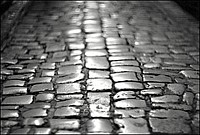 The French government (1806-1814) started a series of changes in the life of the town, especially concerning the schools, economy, agriculture, health service etc.
The French government (1806-1814) started a series of changes in the life of the town, especially concerning the schools, economy, agriculture, health service etc.The Austrian government lasted from 1814 to 1918. In this time the aristocratic families declined more and more and the citizens took step by step the politic and cultural leadership. This was also the time of the Croatian National Renewal and the fight for power between the Autonomy- and the Peoples Party.
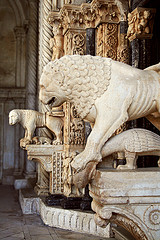 At the beginning of the 20th century new public buildings were built, and the harbor promenade was arranged. After the World War I. the town became part of the Kingdom of Serbs, Slovenes and Croats. Trogir was then part of the Kingdom Yugoslavia and later of the communist Yugoslavia (FNRJ and SFRJ).
At the beginning of the 20th century new public buildings were built, and the harbor promenade was arranged. After the World War I. the town became part of the Kingdom of Serbs, Slovenes and Croats. Trogir was then part of the Kingdom Yugoslavia and later of the communist Yugoslavia (FNRJ and SFRJ).The town Trogir has also survived a few wars, including the last Home War, so that it welcomed the end of the 20th century in an independent Croatia. The wealth and the variety of its cultural heritage and the interesting history of the town are the main reasons, why the town is since 1997 under the protection of the UNESCO.
We can say without exaggeration that Trogir is an unavoidable holiday destination!
Marina, Trogir
 A perfect harmony of sun, sea, stone and man. Marina near Trogir is a village were you can relax the body and feed the soul... A combination of the ancient and the modern, old customs and tradition combine with the present way of living....
A perfect harmony of sun, sea, stone and man. Marina near Trogir is a village were you can relax the body and feed the soul... A combination of the ancient and the modern, old customs and tradition combine with the present way of living....Here, you can experience more than an ordinary holiday: sail, dive, go fishing, drive with the boat or be a captain yourself on a boat or a yacht, which you can rent according to your wishes.
The nearness of the ancient town of Trogir (12 km) and Split (36 km) offers you the possibility of finding yourself in a few minutes in an unusual ambient of monuments of the highest category but also in the modern night- life of bars and discotheques..
If you enjoy the atmosphere of old Dalmatian taverns/ konobas, good fish and domestic brandy, you don't have to go nowhere else apart from your holiday village.
The sandy beach of Marina, beside the clear sea and the shadow under old olive trees and pines offer you refreshment in the restaurant and the aperitiv-bar.
Lumbarda
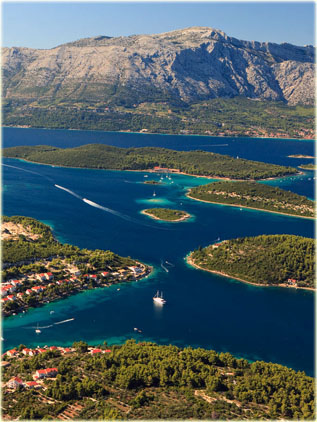
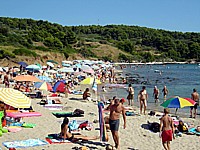
Today the local people are also engaged in tourism: there are hotels, several camps, many private pensions, restaurants, shops, and a small marina. The Ivo Lozica cultural and performing society in Lumbarda cultivates music, singing, folk dancing and amateur dramatics.
City of Korcula
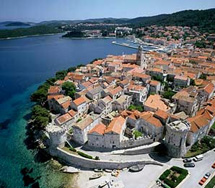
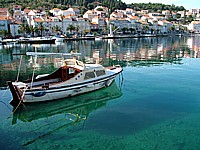 The 10c century Byzantine historian Emperor Constantine Porphyrogenitus was the first to mention a medieval city on the island of Korcula. He wrote about a "walled city". There are many indications that this city was located on the site of today's old part of Korcula, but no remains of Romanesque architecture from that time have been found. What remains of the old city walls, decorations, and most of all archive documents, show that a walled city existed on this site in the 13th century. It had squares and streets, churches, public buildings and houses.
The 10c century Byzantine historian Emperor Constantine Porphyrogenitus was the first to mention a medieval city on the island of Korcula. He wrote about a "walled city". There are many indications that this city was located on the site of today's old part of Korcula, but no remains of Romanesque architecture from that time have been found. What remains of the old city walls, decorations, and most of all archive documents, show that a walled city existed on this site in the 13th century. It had squares and streets, churches, public buildings and houses. 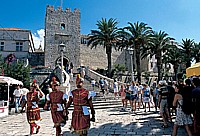 In the second half of the 14th century stone-carving went through a stage of rapid growth in Korcula, thanks primarily to the needs of Dubrovnik master builders for high quality stone. They came to the stone quarries of Korcula and Vrnik and with the help of local workers dressed stone to be shipped to Dubrovnik. Working alongside those excellent masters the men of Korcula learned the trade and in time became skilled enough to establish their own workshops. After that they began to receive orders for stone from Dubrovnik, and they also worked for the needs of the island. Growing more prosperous, they began to build new houses in Korcula with Gothic decorations.
In the second half of the 14th century stone-carving went through a stage of rapid growth in Korcula, thanks primarily to the needs of Dubrovnik master builders for high quality stone. They came to the stone quarries of Korcula and Vrnik and with the help of local workers dressed stone to be shipped to Dubrovnik. Working alongside those excellent masters the men of Korcula learned the trade and in time became skilled enough to establish their own workshops. After that they began to receive orders for stone from Dubrovnik, and they also worked for the needs of the island. Growing more prosperous, they began to build new houses in Korcula with Gothic decorations.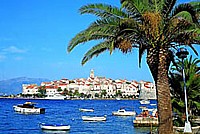 At the beginning of the 16th century houses that had by then not been renewed got Renaissance decorations. This was a time when the city underwent real "polishing": squares and streets were paved, ornate coats-of-arms were placed on buildings, decorative columns added, but the old city nucleus retained its Gothic stamp. In the following 17th and 18th Baroque centuries building and stone-carving declined because economic conditions in Venice deteriorated, which was reflected on areas under Venetian control.
At the beginning of the 16th century houses that had by then not been renewed got Renaissance decorations. This was a time when the city underwent real "polishing": squares and streets were paved, ornate coats-of-arms were placed on buildings, decorative columns added, but the old city nucleus retained its Gothic stamp. In the following 17th and 18th Baroque centuries building and stone-carving declined because economic conditions in Venice deteriorated, which was reflected on areas under Venetian control. 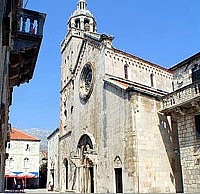 In the 17th century there was no more danger from the Turks so building in Borgo continued and the suburb was enlarged. Soon it became the centre of urban life and work. This was where people traded, where the major craftsmen worked, and very soon other forms of social and public life moved to that part of the town. At that time the number of inhabitants in the old city nucleus decreased: old houses were not repaired, people preferred to build new houses along the seashore near their workshops. Some old houses were reconstructed, but without attention to style so Gothic decorations were removed or destroyed. In this way many valuable buildings and carvings were lost.
In the 17th century there was no more danger from the Turks so building in Borgo continued and the suburb was enlarged. Soon it became the centre of urban life and work. This was where people traded, where the major craftsmen worked, and very soon other forms of social and public life moved to that part of the town. At that time the number of inhabitants in the old city nucleus decreased: old houses were not repaired, people preferred to build new houses along the seashore near their workshops. Some old houses were reconstructed, but without attention to style so Gothic decorations were removed or destroyed. In this way many valuable buildings and carvings were lost.In the first half of the 19th century, right until the Second World War, Korcula was a small provincial town that slowly began to turn to tourism, because its earlier main crafts of stone carving and shipbuilding were pushed back by industrial production and a new way of life. Several small hotels and summer houses near the town were built at that time.
After the Second World War an industrial shipyard was founded and accommodation was needed for its workers, so new residential estates were built to the east and west of the city on the slopes above the sea, larger hotels, public buildings, a new quay, roads, a marina. In the old part of the city ruinous or damaged houses were repaired to be lived in and for public use, for example to house museums and the like.
Komiza
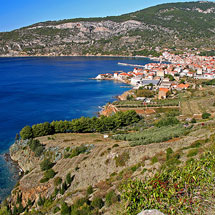
It is a typical Mediterranean village, which attracts the tourists with beautiful beaches and with narrow roads and houses squeezed together around the harbour.
Thanks to the mild Mediterranean climate, the stay in Komiza is pleasant also in the winter months. There are gravel beaches along the whole east coast of the Bay of Komiza with sources of drinking water: Gusarica, Nova posta, Velo zalo.
 The name Komiza was mentioned for the first time in the second part of the 12th century. Komiza is a village where the fishing on the eastern side of the Adriatic Sea was born.
The name Komiza was mentioned for the first time in the second part of the 12th century. Komiza is a village where the fishing on the eastern side of the Adriatic Sea was born.Its fishers not only ruled with their boats over the Adriatic Sea but they also traded with the neighbouring coast creating fishermen's centres on the Pacific coasts of both Americas.
Komiza has always been proud of the fisherman's history, whose remains can be found in the Fisherman's museum located in the old Venetian tower on the promenade (riva), the only one in Croatia. The traditional fishing tools are displayed in it.
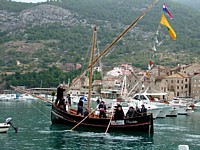 The whole history of the island of Vis on one hand politically and economically connected to the fishing, and on the other hand with the wine-production, which today is also the basis of economy and the pledge of future.
The whole history of the island of Vis on one hand politically and economically connected to the fishing, and on the other hand with the wine-production, which today is also the basis of economy and the pledge of future.More than two thousand years passed since the first written laudation of the wine from Vis, and there are only few people who didn't hear about the wine vugava and plavac mali or didn't taste it.
In the last years the agro tourism has been developed in 10 rural house-holds on Vis and Bisevo.
The local culinary specialities (domestic bread-komiska pogaca, dishes under the baking-lid, pilchards on the grill, beans and noodles on fish stew- brodetto) are offered together with domestic wine. Its not possible to imagine the traditional dishes without these fruits of the sea.
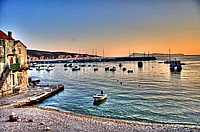 The lovers of sports and active holiday can choose between parachute-sailing, riding, walking in nature and diving. There are 20 locations in the depths of the sea with sunken planes, sailing-ships, submarines and war-ships in the surrounding of Vis.
The lovers of sports and active holiday can choose between parachute-sailing, riding, walking in nature and diving. There are 20 locations in the depths of the sea with sunken planes, sailing-ships, submarines and war-ships in the surrounding of Vis.If you are interested in culture and entertainment, visit the Fisherman's museum and the music- drama manifestations of the Cultural summer of Komiza, when you can hear the klapa-songs from the taverns/ konobas.
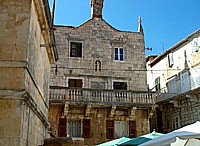 For more than 25 years the International Ballet school is being opened during the summer in Komiza in which the pupils from the whole world get knowledge and achieve dancing perfectionism in classical ballet, and in pop and modern jazz , under the leadership of the ballet- pedagogue Jozo Borcic from Komiza.
For more than 25 years the International Ballet school is being opened during the summer in Komiza in which the pupils from the whole world get knowledge and achieve dancing perfectionism in classical ballet, and in pop and modern jazz , under the leadership of the ballet- pedagogue Jozo Borcic from Komiza.The manifestation culminates every year with a final ballet concert in the hall of the Memorial home, which makes the numerous visitors of Vis enthusiastic.
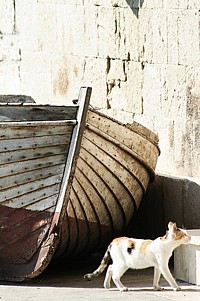 The harbour of Komiza offers the yachtsmen good berths protecting them from the northern and eastern winds, and it is totally open to the northwest.
The harbour of Komiza offers the yachtsmen good berths protecting them from the northern and eastern winds, and it is totally open to the northwest.The jugo- wind can cause unpleasant waves in the harbour. Because of the openness of the harbour and its depth the construction of new berths is complicated.
This is the reason why there s planned to build a big fisherman's port with a fish bazaar, located in front of the former factory for the conservation of fish Neptun. It will be used by the fisher- boats of Komiza and other ones and domestic boats, while some of the berths in the harbour would be then free for the commercial use.
The new owners of the former factory Neptun plan to transform it into an important touristic center, and together with the fisherman's harbour it will help to attract the guests on the island during the whole year.
These are the prerequisites for the revitalisation of the economy of Komiza and the whole island.
Rukavac
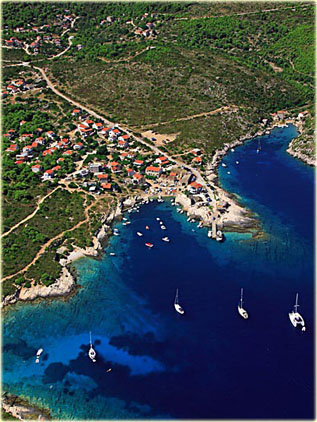
Rukavac is a quiet and picturesque place, formerly a fishing town and now a real tourist resort. It is 10 km from Vis and 16 km from Komiža. It is located on the southeastern side of the island of Vis and is also the largest town and the safest harbor on the southern side of the island. In the immediate vicinity are numerous beaches, and the most famous is the "Srebrena" beach which is a natural pebble beach considered to be one of the most beautiful beaches of Dalmatia, numerous islands and islets of which the most famous is the island of Ravnik with the famous natural phenomena, "The Green Cave".
Till recently, Rukavac was a typical small Dalmatian fishing town, and today it is one the most famous tourist destinations in the island of Vis, foremost because of its beautiful beaches and its large offer of quality accommodation in private houses and apartments. A vacation in Rukavac is ideal for those who want to enjoy beautiful beaches and crystal clear sea, beautiful natural surroundings in a true Mediterranean environment. The town offers the possibility of renting small motor boats which represents an ideal way for sight-seeing the nearby bays and islands. The sea is exceptionally rich with fish, so Rukavac also represents a favorite destination of underwater fishing on the island of Vis. The town has a market and a restaurant where you can enjoy local gastronomic specialties and excellent Vis wine.

No comments:
Post a Comment